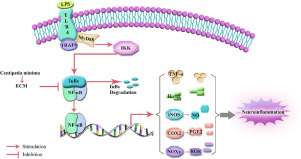当前位置:
X-MOL 学术
›
Phytomedicine
›
论文详情
Our official English website, www.x-mol.net, welcomes your feedback! (Note: you will need to create a separate account there.)
Centipeda minima extract exerts antineuroinflammatory effects via the inhibition of NF-κB signaling pathway.
Phytomedicine ( IF 7.9 ) Pub Date : 2019-12-30 , DOI: 10.1016/j.phymed.2019.153164 Si-Yi Li 1 , Yi-Le Zhou 1 , Dan-Hua He 1 , Wei Liu 1 , Xiang-Zhen Fan 1 , Qi Wang 1 , Hua-Feng Pan 1 , Yong-Xian Cheng 2 , Yong-Qiang Liu 1
Phytomedicine ( IF 7.9 ) Pub Date : 2019-12-30 , DOI: 10.1016/j.phymed.2019.153164 Si-Yi Li 1 , Yi-Le Zhou 1 , Dan-Hua He 1 , Wei Liu 1 , Xiang-Zhen Fan 1 , Qi Wang 1 , Hua-Feng Pan 1 , Yong-Xian Cheng 2 , Yong-Qiang Liu 1
Affiliation

|
BACKGROUND
Centipeda minima (L.) A.Br. (C. minima) has been used in traditional Chinese herbal medicine to treat nasal allergy, diarrhea, asthma and malaria for centuries. Recent pharmacological studies have demonstrated that the ethanol extract of C. minima (ECM) and several active components possess anti-bacterial, anti-arthritis and anti-inflammatory properties. However, the effects of ECM on neuroinflammation and the underlying mechanisms have never been reported.
PURPOSE
The study aimed to examine the potential inhibitory effects of ECM on neuroinflammation and illustrate the underlying mechanisms.
METHODS
High performance liquid chromatography-tandem mass spectrometry (HPLC-MS/MS) was performed to qualify the major components of ECM; BV2 and primary microglial cells were used to examine the anti-inflammatory activity of ECM in vitro. To evaluate the anti-inflammatory effects of ECM in vivo, the mice were orally administrated with ECM (100, 200 mg•kg-1•d-1) for 2 days before cotreatment with LPS (2 mg•kg-1•d-1, ip) for an additional 3 days. The mice were sacrificed the day after the last treatment and the hippocampus was dissected for further experiments. The expression of inflammatory proteins and the activation of microglia were respectively detected by real-time PCR, ELISA, Western blotting and immunofluorescence.
RESULTS
HPLC-MS/MS analysis confirmed and quantified seven chemicals in ECM. In BV2 and primary microglial cells, ECM inhibited the LPS-induced production of tumor necrosis factor-α (TNF-α) and interleukin-1β (IL-1β), thus protecting HT22 neuronal cells from inflammatory damage. Furthermore, ECM inhibited the LPS-induced activation of NF-κB signaling pathway and subsequently attenuated the induction of inducible nitric oxide synthase (iNOS), cyclooxygenase 2 (COX2), NADPH oxidase 2 (NOX2) and NADPH oxidase 4 (NOX4), leading to the decreased production of nitrite oxide, prostaglandin E2 (PGE2) and reactive oxygen species (ROS). In an LPS-induced neuroinflammatory mouse model, ECM was found to exert anti-inflammatory activity by decreasing the production of proinflammatory mediators, inhibiting the phosphorylation of NF-κB, and reducing the expression of COX2, iNOS, NOX2 and NOX4 in the hippocampal tissue. Moreover, LPS-induced microglial activation was markedly attenuated in the hippocampus, while ECM at a high dose possesses a stronger anti-inflammatory activity than the positive drug dexamethansone (DEX).
CONCLUSION
These findings demonstrate that ECM exerts antineuroinflammatory effects via attenuating the activation of NF-κB signaling pathway and inhibiting the production of proinflammatory mediators both in vitro and in vivo. C. minima might become a novel phytomedicine to treat neuroinflammatory diseases.
中文翻译:

小enti提取物通过抑制NF-κB信号传导途径发挥抗炎作用。
背景最小enti(L.)A.Br. (C. minima)在传统中草药中已用于治疗鼻部过敏,腹泻,哮喘和疟疾已有数百年历史了。最近的药理研究表明,最小梭状芽孢杆菌(ECM)的乙醇提取物和几种活性成分具有抗菌,抗关节炎和抗炎的特性。但是,ECM对神经发炎及其潜在机制的影响尚未见报道。目的该研究旨在检查ECM对神经炎症的潜在抑制作用,并阐明其潜在机制。方法采用高效液相色谱-串联质谱法(HPLC-MS / MS)鉴定ECM的主要成分。BV2和原代小胶质细胞用于体外检测ECM的抗炎活性。为了评估ECM在体内的抗炎作用,在与LPS(2 mg•kg-1•d-)共同治疗之前,给小鼠口服ECM(100,200 mg•kg-1•d-1)2天。 1,ip)需额外3天。最后一次治疗后第二天将小鼠处死,解剖海马以进行进一步的实验。实时荧光定量PCR,酶联免疫吸附测定,免疫印迹和免疫荧光检测炎症蛋白的表达和小胶质细胞的激活。结果HPLC-MS / MS分析确认并定量了ECM中的7种化学物质。在BV2和原代小胶质细胞中,ECM抑制LPS诱导的肿瘤坏死因子-α(TNF-α)和白介素-1β(IL-1β)的产生,从而保护HT22神经元细胞免受炎性损害。此外,ECM抑制LPS诱导的NF-κB信号通路激活,随后减弱诱导型一氧化氮合酶(iNOS),环氧合酶2(COX2),NADPH氧化酶2(NOX2)和NADPH氧化酶4(NOX4)的诱导,导致减少了亚硝酸盐,前列腺素E2(PGE2)和活性氧(ROS)的产生。在LPS诱导的神经炎症小鼠模型中,发现ECM通过减少促炎性介质的产生,抑制NF-κB的磷酸化以及减少海马组织中COX2,iNOS,NOX2和NOX4的表达发挥抗炎活性。 。此外,LPS诱导的小胶质细胞激活在海马区明显减弱,而高剂量的ECM具有比阳性药物地塞米松(DEX)更强的抗炎活性。结论这些发现表明,ECM通过减弱NF-κB信号通路的激活并抑制体内和体外促炎性介质的产生来发挥抗炎作用。微小隐孢子虫可能成为治疗神经炎性疾病的新型植物药。
更新日期:2019-12-30
中文翻译:

小enti提取物通过抑制NF-κB信号传导途径发挥抗炎作用。
背景最小enti(L.)A.Br. (C. minima)在传统中草药中已用于治疗鼻部过敏,腹泻,哮喘和疟疾已有数百年历史了。最近的药理研究表明,最小梭状芽孢杆菌(ECM)的乙醇提取物和几种活性成分具有抗菌,抗关节炎和抗炎的特性。但是,ECM对神经发炎及其潜在机制的影响尚未见报道。目的该研究旨在检查ECM对神经炎症的潜在抑制作用,并阐明其潜在机制。方法采用高效液相色谱-串联质谱法(HPLC-MS / MS)鉴定ECM的主要成分。BV2和原代小胶质细胞用于体外检测ECM的抗炎活性。为了评估ECM在体内的抗炎作用,在与LPS(2 mg•kg-1•d-)共同治疗之前,给小鼠口服ECM(100,200 mg•kg-1•d-1)2天。 1,ip)需额外3天。最后一次治疗后第二天将小鼠处死,解剖海马以进行进一步的实验。实时荧光定量PCR,酶联免疫吸附测定,免疫印迹和免疫荧光检测炎症蛋白的表达和小胶质细胞的激活。结果HPLC-MS / MS分析确认并定量了ECM中的7种化学物质。在BV2和原代小胶质细胞中,ECM抑制LPS诱导的肿瘤坏死因子-α(TNF-α)和白介素-1β(IL-1β)的产生,从而保护HT22神经元细胞免受炎性损害。此外,ECM抑制LPS诱导的NF-κB信号通路激活,随后减弱诱导型一氧化氮合酶(iNOS),环氧合酶2(COX2),NADPH氧化酶2(NOX2)和NADPH氧化酶4(NOX4)的诱导,导致减少了亚硝酸盐,前列腺素E2(PGE2)和活性氧(ROS)的产生。在LPS诱导的神经炎症小鼠模型中,发现ECM通过减少促炎性介质的产生,抑制NF-κB的磷酸化以及减少海马组织中COX2,iNOS,NOX2和NOX4的表达发挥抗炎活性。 。此外,LPS诱导的小胶质细胞激活在海马区明显减弱,而高剂量的ECM具有比阳性药物地塞米松(DEX)更强的抗炎活性。结论这些发现表明,ECM通过减弱NF-κB信号通路的激活并抑制体内和体外促炎性介质的产生来发挥抗炎作用。微小隐孢子虫可能成为治疗神经炎性疾病的新型植物药。



























 京公网安备 11010802027423号
京公网安备 11010802027423号